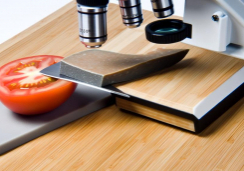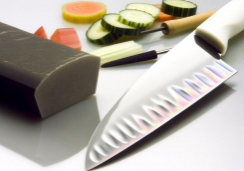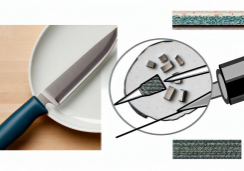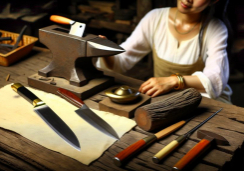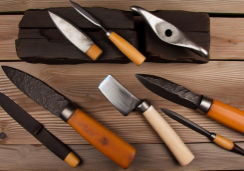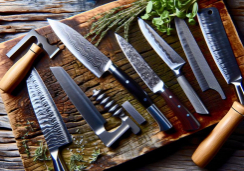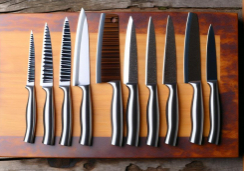Crafting Kitchen Knives: 13 Expert Tips Revealed
When you hold a handcrafted kitchen knife by a master like Bob Kramer, you're not just holding a tool; you're wielding a piece of art that's been meticulously forged, heat-treated, and sharpened to perfection.
You might wonder how such precision and beauty is achieved in these everyday instruments of the culinary world. As you set out to craft your own kitchen knives, it's crucial to understand the nuances that turn a slab of steel into a chef's prized possession.
From selecting the right materials to the finishing touch that defines its edge, each step demands a blend of science and soul. Stay with me, and you'll uncover 13 expert tips that elevate the ordinary to the extraordinary, transforming your blades from mere cutlery to culinary companions that stand the test of time and taste.
Selecting the Right Steel
Choosing the appropriate steel is crucial for your kitchen knife, as it determines the blade's hardness, sharpness retention, and corrosion resistance. When you're in the market for knife steel, you'll encounter a range of alloys, each offering a unique balance of properties.
High-carbon steels, such as 1095, are favored for their ability to maintain a keen edge. They're known for hardness but can be prone to corrosion if not properly cared for. You'll need to weigh the value of edge retention against the maintenance required to prevent rust.
Stainless steels, like the 440C or the popular Japanese VG-10, provide excellent corrosion resistance due to their higher chromium content. They're less likely to rust, making them ideal for a low-maintenance kitchen environment. However, they mightn't hold an edge as well as high-carbon options.
Tool steels, categorized as D2 or A2, are revered for their toughness and wear resistance. They're more challenging to sharpen but offer superior longevity. These are especially suitable for professional settings where knives see frequent and rigorous use.
Ultimately, the right steel for you hinges on your usage patterns and maintenance preferences. Assess these factors critically before making your selection, ensuring your kitchen knife meets both your culinary and care expectations.
Designing Your Knife
Having selected the right steel, you'll now focus on the ergonomic and aesthetic aspects of your kitchen knife's design to ensure it meets your specific cutting needs and style preferences. Begin by considering the knife's purpose. A chef's knife demands a broad blade for chopping, while a paring knife requires a small, agile blade for precision work.
Pay attention to the blade's geometry. The angle of the edge, typically between 15 to 20 degrees, is crucial for sharpness and cutting efficiency. A full tang, where the steel extends into the handle, offers balance and strength, but adds weight. Choose a partial tang for a lighter knife, but don't compromise on stability.
Contemplate the handle's material and shape. It should be durable and resistant to kitchen elements, such as moisture and heat. Materials like stabilized wood, micarta, or G10 provide a secure grip and longevity. The handle's contour must fit snugly in your hand, allowing for control and reducing fatigue during extended use.
Essential Forging Techniques
Mastering forging techniques is essential to transforming your chosen steel into a durable and precise kitchen knife.
Begin with selecting the appropriate steel; high-carbon content is typically favored for its edge retention and hardness. Heat the steel to its critical temperature, where it becomes malleable—this is crucial for proper shaping without damaging the material's structure.
You'll need to understand the basics of tapering, which involves hammering the steel to gradually thin the spine towards the edge. This creates a balance between a sturdy backbone and a sharp cutting surface. Ensure your hammer blows are measured and consistent to avoid warping.
Next, focus on the blade's profile. Establish the knife's shape through a combination of drawing out, where you elongate the steel, and upsetting, where you thicken certain parts. The edge's bevel is created by angling your hammer blows to shape the blade's sides to a fine edge. This requires precision to maintain an even bevel width.
Precision Heat Treatment
Once you've shaped your knife through forging, precise heat treatment becomes critical to lock in the blade's hardness and durability. Achieving the perfect balance of toughness and edge retention requires meticulous control over the heating and cooling processes.
Start by uniformly heating the blade to the austenitizing temperature—this is the point at which the steel's crystal structure transforms, allowing carbon atoms to dissolve into the iron matrix. The exact temperature varies depending on the specific alloy but typically ranges between 1475-1950°F (800-1065°C). Use a calibrated kiln or forge for this task to ensure even heat distribution.
After austenitizing, quenching comes next. You'll need to immerse the blade swiftly in a quenching medium such as oil, water, or air. The choice of quenchant depends on the steel type, with oil being common for many high-carbon steels. Quenching too slowly can cause the blade to lose potential hardness, so speed is of the essence here.
Finishing and Sharpening
After heat treatment, your knife's edge must be meticulously ground and polished to achieve the ultimate sharpness and finish. Begin with a coarse grit belt or stone to grind the edge, creating the initial bevel. You'll want to maintain a consistent angle, which is typically between 15 to 20 degrees for kitchen knives.
Progress through finer grits, methodically refining the edge. It's essential to cool the blade frequently during grinding to prevent overheating, which can lead to a loss of temper and reduce the blade's hardness.
Polishing is next, and it's not merely aesthetic. Use a buffing wheel or stropping leather charged with a fine abrasive compound to eliminate any burr and to align the microstructure of the steel, enhancing the edge's keenness and durability.
The difference between a well-finished knife and a mediocre one lies in the attention to these details.
Conclusion
Now that you've mastered the essentials of crafting kitchen knives, remember the devil's in the details.
Selecting top-notch steel sets a solid foundation, while your design dictates functionality.
Forging with precision shapes the blade's soul, and accurate heat treatment ensures resilience.
Finally, meticulous finishing and sharpening bring out the knife's true edge.
Hone these skills, and you'll create not just a tool, but a culinary extension of the chef's hand.
Craft with passion and precision.

